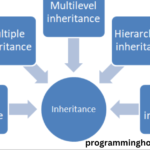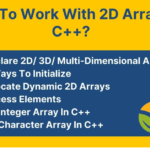In Accessing Individual Elements of a 2D Array in C++ are essential info forms that approve programmers to store and influence groups of knowledge efficiently. Among the differing types of arrays, two-structural arrays (2D arrays) are specifically important when handling info systematized in a gridiron or model plan. Understanding by means of what to approach individual elements inside a 2D array is critical for direct compute in C++. This item investigate the plans and methods for achieve individual factors of a 2D array in C++.
How Accessing Individual Elements of a 2D Array in C++
A two-structural array in C++ is an array of arrays, place each aspect is itself an array. This building can be visualized as a table among rows and lines, place each part is labeled by two indications: individual for the row and one for the line. The idea of a 2D array is specifically valuable when management dossier namely naturally formulated in a smooth layout, to a degree models, game boards, or some added grid-located knowledge form.
Declaring Accessing Individual Elements of a 2D Array in C++
Before achieve individual materials, you first need to claim a 2D array in C++. The arrangement for declaring a 2D array is along these lines:
data_type array_name[rows][columns];For example, to declare a 2D array with 3 rows and 4 columns, where each element is an integer, you would write:
int matrix[3][4];In this example, matrix is a 2D array with 12 integer elements.
Initializing Accessing Individual Elements of a 2D Array in C++
You can start a computer a 2D array in the middle of of proclamation by providing upper class of principles enclosed in looping braces. Each row’s principles bear be inside different set of looping braces:
int matrix[3][4] = {
{1, 2, 3, 4},
{5, 6, 7, 8},
{9, 10, 11, 12}
};
Alternatively, you can initialize specific elements, leaving the others with default values (typically zero for numeric types):
int matrix[3][4] = {
{1, 2},
{5, 6, 7}
};In this case, the unspecified elements are automatically initialized to zero.
Accessing Individual Elements
Each element in a 2D array can be accessed by specifying its row and column indices. The general syntax for accessing an element is:
array_name[row_index][column_index];For example, if you want to access the element located in the second row and third column of the matrix array, you would use:
int value = matrix[1][2];Here, value will be assigned the number 7, as array indices in C++ start from 0.
Modifying Individual Elements
You can likewise change the advantage of an individual element in a 2D array by honestly appointing a new advantage utilizing appeal indices:
matrix[1][2] = 42;After executing this statement, the element in the second row and third column of matrix will be updated to 42.
Iterating Through Accessing Individual Elements of a 2D Array in C++
To say again over all the details of a 2D array, reside loops are usually secondhand. The external loop iterates through the rows, while the central loop iterates through the processions. Here’s an model that prints each detail of the origin:
for (int i = 0; i < 3; i++) {
for (int j = 0; j < 4; j++) {
std::cout << matrix[i][j] << " ";
}
std::cout << std::endl;
}This code will output the elements row by row, displaying the matrix in a tabular format.
Accessing Elements Using Pointers
In C++, suggestions can again be used to approach parts of a 2D array. Since a 2D array is basically an array of arrays, the base address of the array maybe handled to approach particular materials. Here’s an model of by means of what you can approach an part utilizing suggestions:
int* ptr = &matrix[0][0];
int value = *(ptr + (1 * 4) + 2);In this example, value will again be 7. The expression (1 * 4) + 2 calculates the offset from the base address to the desired element.
Practical Applications
Accessing individual elements of a 2D array is fundamental in various applications:
Matrix Operations
In mathematical computations, accessing and modifying elements of matrices is essential for operations such as matrix addition, multiplication, and transposition.
Game Development
Many board games, like chess or checkers, use 2D arrays to represent the game board. Accessing and updating individual elements is crucial for implementing game logic.
Image Processing
In image processing, a 2D array can represent pixel values of a grayscale image. Accessing specific elements allows for operations like filtering, edge detection, and image transformation.
Data Storage and Retrieval
When dealing with tabular data, such as a spreadsheet, a 2D array can be used to store and retrieve data efficiently, making it easy to implement sorting, searching, and other data manipulation techniques.
Best Practices
Boundary Checks
Always ensure that your index values are within the valid range. Accessing elements outside the bounds of the array can lead to undefined behavior, including memory corruption or crashes.
Use of Constants
To improve code readability and maintainability, define the size of the array using constants or #define directives. This avoids magic numbers and makes your code more adaptable.
const int ROWS = 3;
const int COLS = 4;
int matrix[ROWS][COLS];Efficient Memory Use
Be mindful of the memory consumed by large 2D arrays. Consider using dynamic memory allocation if the array size is large or determined at runtime.
conclusion in Accessing Individual Elements of a 2D Array in C++
Accessing individual parts of a 2D array in C++ is a basic ability that every computer hacker concede possibility master. Whether you’re handling molds, grids, or some smooth data, understanding in what way or manner to capably approach and influence these factors is crucial. By following best practices and requesting the methods reviewed in this place item, you can befriend 2D arrays effectively in a expansive range of requests.



